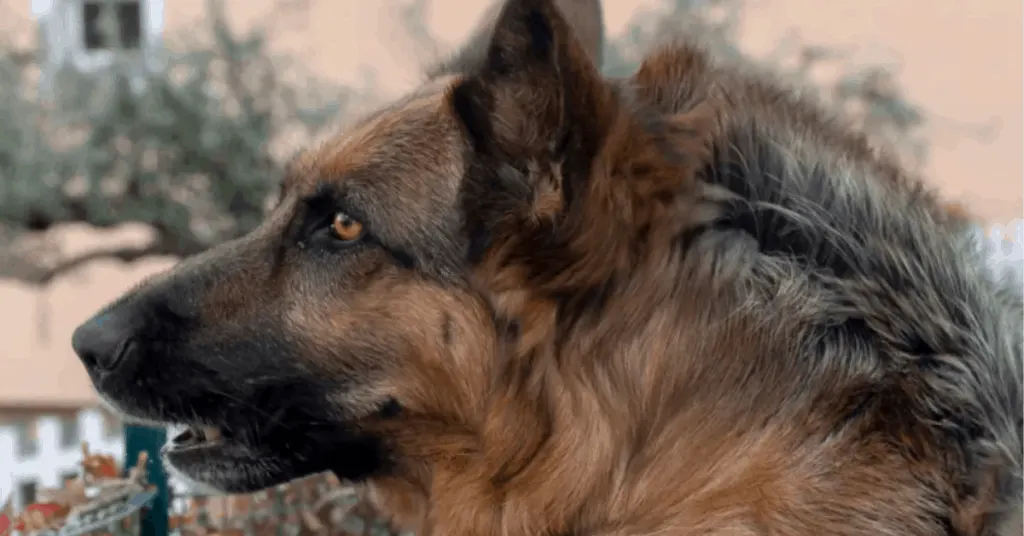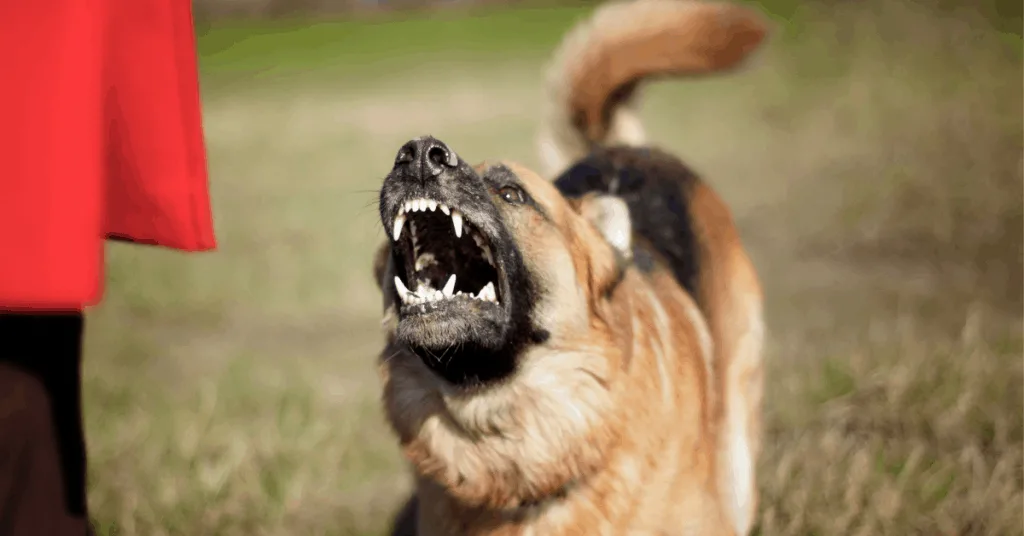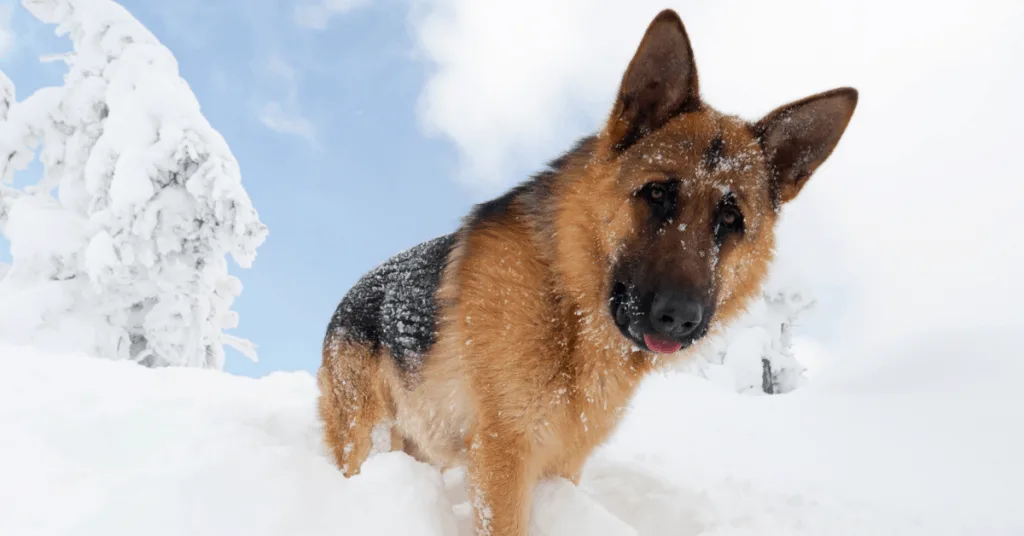
German Shepherds can’t speak, so they communicate through other means; one of which is body language. Their tails and ears are expressive and let you know when they are happy, sad, scared, sorry, etc.
Another way that they communicate is with their hackles. Your German Shepherd’s hackles are the patches of hair along their neck and back, and they often stand up in response to emotions.
German Shepherds’ hair stands up in response to certain emotions and physiological conditions. The following can cause raised hackles:
- Aggression
- Excitement
- Anxiety and fear
- Predatory instincts
- Extreme cold
- Medical disorders
When your German Shepherd’s hackles stand up, it is usually an indication of certain different emotions, not just aggression, which is the most commonly known reason.
Hackles act more like the hairs on your arms and legs rather than the hair on your head, and so raised hackles can also be a physiological response to the environment or even a sign of a medical issue.
The Physiological Mechanism of Hackles
A German Shepherd’s hackles are raised by the arrector pili muscles, which contract in response to a sympathetic nervous system reflex known as piloerection.
The arrector pili muscles surround the hair follicles, and they contract when stimulated. This contraction pulls on the hair follicles and causes the hairs to stand up.
Piloerection can be triggered by emotions or by cold, and there are also instances where neurological conditions can result in inappropriate piloerection.
German Shepherds are not the only dogs that can display raised hackles, but the length and texture of their hair make its effects very pronounced in a German Shepherd.
Raised hackles are an involuntary reflex, and when triggered by emotion, you will have to look for other signs to indicate what that emotion is.
Some research indicates that the location and spread of the raised hair can show what triggered the response. However, this research is not well-substantiated at this stage, and a better indication will be looking at the accompanying behavior.
In this article, we will take a close look at six reasons why your German Shepherd’s hair stands up, and will also provide you with actionable steps to address this issue. Read on to learn more!
Click Here to Jump to a Section
German Shepherd Hair Stands Up In Response To Aggression
Your German Shepherd’s hair can stand up when they are aggressive or defensive. German Shepherds are a more aggressive breed or dog, but this aggression only becomes a problem if their owners do not train and handle them properly.
If you train and handle your German Shepherd properly, any aggression that they do display will be a more appropriate response to certain situations as opposed to problematic behavior.

German Shepherds were initially bred as herders, and their protective instincts are well developed. If they think that someone or something is posing a threat to their owner, property, or themselves, their emotional state will trigger piloerection, and you will see their hackles raised.
This response is designed to make your German Shepherd look bigger than they are and indicate to a potential threat that they are not to be messed with.
Signs Indicating Aggression
If your German Shepherd’s hackles are raised, there are other signs to look for that would identify aggression as the cause of the raised hair:
- Growling and snarling
- A stiff tail that is upraised or curving over the dog’s back
- Bared teeth and snapping
- Stiff posture
- Ears pinned back
Reducing Aggression In German Shepherds And Handling It In The Moment
If you notice that your German Shepherd’s hackles are raised out of aggression, you may need to stop the behavior, but you need to take care of how you do this because you don’t want your German Shepherd to think that protecting you is bad behavior.
Here are some immediate and longer term actionable steps that you can take to address the issue of your German Shepherd’s raised hackles:
Take your German Shepherd for obedience training
GSDs absolutely love the mental and physical stimulation of training and thrive on being able to spend time with you and please you.
Having a big, protective dog like a German Shepherd means that you need them to listen to and obey you. Being able to make them sit or stay can go a long way to de-escalating an aggressive situation.
Stay calm
Remember that your German Shepherd doesn’t understand your words; they listen to your tone. If you start shouting at them for acting aggressively, they can take this to mean that the situation is making you aggressive as well, so they must be responding correctly.
Not only will it not check the behavior, but it can also cause a swift escalation, and your German Shepherd, who was just previously growling, may decide to attack.
Walk away
If your German Shepherd is not responding to your commands, you can try to walk them away if they are on a lead. Stay calm and don’t run. They are more than likely thinking that you need protection, so if you show them you are moving away, they should follow.
Break their concentration
When your German Shepherd is inappropriately aggressive, you may need to break their concentration to get them to stand down. You can move into their line of sight to catch their attention. Give them their obedience commands; sit and stay, etc.
German Shepherd Hair Stands Up In Response To Excitement
Excitement can also trigger piloerection and cause your German Shepherd’s hackles to stand up, even while they are playing. This is more common in puppies, but it can also continue into adulthood.
Signs Indicating Excitement
If your German Shepherd’s hackles are raised, there are other signs to look for that would identify excitement as the cause of the raised hair:
- Running around in circles.
- Barking or yipping.
- Jumping up and down.
- Wagging tail.
Reducing Excitement In German Shepherds And Handling It In The Moment
Raised hackles while playing or greeting you is not a sign that your German Shepherd is angry, but overexcitement can cause situations to get out of control, and you should try to calm them down.
Exercise your German Shepherd enough
Your German Shepherd is more likely to become overexcited if they have not had enough physical exercise to work off their energy. By exercising your dog every day, you can minimize the chances of excitement becoming problematic.
Don’t excite them further
If your German Shepherd is acting overexcited, don’t rile them up further. Don’t punish them for this excitement but respond calmly. Get them to do their obedience tricks (sit, stay, lie-down, etc.).
They love to please you, and the act of concentrating on obeying you can calm them down. When they do calm down, you can reward them with attention or treats to reinforce this good behavior.
German Shepherd Hair Stands Up In Response To Anxiety Or Fear
Anxiety and fear responses in German Shepherds are worse if they have not had proper socialization as puppies.
While raised hackles can be a sign of anxiety or fear in your German Shepherd, the other responses and signs can differ depending on if your dog responds to anxiety with aggression or timidity.
Related: German Shepherd Aggression: Why and What to Do About It
Signs Indicating Anxiety Or Fear
If your German Shepherd’s hackles are raised, there are other signs to look for that would identify anxiety or fear as the cause of the raised hair:
- Sudden and persistent barking
- Growling
- Darting eyes (looking for an escape)
- Cowering
- Whining
- Tucked tail
- Involuntary urination
Reducing Anxiety And Fear In German Shepherds And Handling It In The Moment
An anxious and fearful German Shepherd can be very unpredictable. They may switch from cowering to attacking without warning. They are also distressed when they respond in this way, so it is important for you to calm them down.
Socialization
Must read related article: How To Socialize Your German Shepherd
Socialization is such an important part of owning a German Shepherd. They were bred to be herders, working alone with their owners, and so without good socialization, they can develop inappropriate and potentially dangerous behaviors.
Proper introductions
If your German Shepherd meets a person for the first time, don’t leave them alone with that person, and don’t let that person suddenly rush at your dog or try to pet them before your German Shepherd is comfortable.
Don’t lock them in with the new person; let your German Shepherd leave if that is what they prefer. Once they see you the new person is not behaving dangerously, they may return and initiate contact.
The same principles apply to introducing new animals. Let them do it in their own time and remain calm.
You can reward good behavior but don’t try to comfort them if they are scared. Instead of patting your dog, shake the person’s hand or pat the other dog to show that everything is fine.
Minimize separation anxiety
German Shepherds are prone to separation anxiety because of their intense loyalty to their humans. If you are always leaving your German Shepherd, they can develop separation anxiety, which keeps them primed for an emotional response to other situations.
Related: How to Deal with German Shepherd Separation Anxiety
Make sure that you spend regular time with your German Shepherd so that they know when to expect you and that when you are home, they can be with you.
German Shepherd Hair Stands Up In Response To Predatory Instinct
German Shepherds do have a prey-drive. While this has diminished over the years and is not as well-developed as in other breeds such as Huskies, they can still respond with raised hackles to the sight of a squirrel, rabbit, or cat.
Signs Indicating Activated Predatory Instinct
If your German Shepherd’s hackles are raised, there are other signs to look for that would identify predatory instinct or prey-drive as the cause of the raised hair:
A sudden interest in what is moving
Ears pricked up and listening for sounds to indicate when the potential prey is. Contrary to popular belief, German Shepherds are not color blind, but they do see things quite differently than humans.
Be sure to watch the video below. It will give you great insight (no pun intended!) into just how German Shepherds see the world and sense movement.
German Shepherds are very adept at noticing even the tiniest of movements. Keep this in mind and pay attention to your GSD’s surroundings as the possible cause for raised hackles.
Not paying attention when you call
If you notice that your German Shepherd is distracted and not listening to you, chances are that your dog is not simply ignoring you. Instead, something else has your dog’s attention.
This behavior means that it’s time for you to start paying very close attention to your dog, as it is often a sign that your German Shepherd is focusing in on something that it is interpreting as prey.
Reducing Predatory Instinct In German Shepherds And Handling It In The Moment
It is important to reduce your German Shepherd’s predatory instincts or prey drive, especially if you have cats or other small pets.
Related: Do German Shepherds Get Along With Cats?
Some dogs are completely fine until one day they experience the thrill of the chase, and from then on, they will always chase. Other dogs with higher prey drives can trigger this.
Obedience training and socialization with other pets
Being able to call your dog off and teaching them how to interact with different animals can help curb this instinct.
Therefore, it is important that you take this aspect of German Shepherd ownership seriously, as good behavior taught early on will set the tone for a lifetime.
Stop your GSD from prowling
If your German Shepherd goes out prowling in your yard or on the walk, stop them before they find something to chase. Call them to your side and reward them for their obedience.
You may find that this takes some practice. But if you keep at it in a consistent manner, you will help your GSD to develop the habit of checking in with you before venturing out on their own.
German Shepherd Hair Stands Up In Response To Cold
Survival instincts trigger the sympathetic nervous system. When your German Shepherd gets very cold, piloerection is triggered. The purpose of this reflex is to trap a layer of hair against your dog’s body.
The body will then use its limited resources to heat that air and hold it against the body as protection from the cold air.
Related: What Temperatures Can German Shepherds Tolerate?
This is also what happens when humans get cold, and it causes goosebumps, although our ‘fur coats’ are significantly less effective insulators.
Signs Indicating That Your German Shepherd Is Cold
If your German Shepherd’s hackles are raised, there are other signs to look for that would identify extreme cold as the cause of the raised hair:
- Shivering
- Curling up
- Sitting close to you
- Lethargy
- Pale gums
Keeping Your German Shepherd Warm In Cold Weather

Their thick coats make German Shepherds ideal for cold climates. However, there is still a risk of your dog developing hypothermia if they are overexposed to the cold, and you should respond immediately if they start showing signs of being cold, such as raised hackles.
Keep them indoors when it’s very cold. You can let your German Shepherd out for short periods of time, but they should be kept indoors mostly or at least have access to indoors when they choose.
Provide them with physical activity. This is important for generating heat and keeping your German Shepherd content to be indoors during the cold snaps.
Provide them with warm beds and jackets. These will reduce how hard your German Shepherd’s body has to work to keep them warm.
Protect their feet. Dogs lose heat from their paws, so protecting them with paw wax or boots (if you can keep them on and your German Shepherd will walk with them on) can minimize this heat loss.
Keep them dry. Refrain from bathing your German Shepherd during very cold weather. Dry them off when they come inside from the rain or snow.
German Shepherd Hair Stands Up In Response To Medical Issues
Sometimes your German Shepherd’s hackles can be raised in response to a medical condition. Pain can cause raised hackles, as can neurological diseases such as epilepsy.
If you suspect a medical cause of piloerection, take your German Shepherd to see a veterinarian.
Signs Indicating That Your German Shepherd Is In Pain
If your German Shepherd’s hackles are raised, there are other signs to look for that would identify pain as the cause of the raised hair:
- Whining
- Avoiding certain movements or hesitant movements
- Not wanting to be touched. They may even show signs of aggression or fear in this case
- Restlessness
- Loss of appetite
- General signs of distress
Signs Indicating That Your German Shepherd Is Suffering From An Epileptic Seizure
If your German Shepherd’s hackles are raised, there are other signs to look for that would identify epilepsy as the cause of the raised hair:
- Raised or slowed heart rate
- Excessive salivation
- Uncontrolled defecation and urination
- Muscle spasms
- Pupil dilation and constriction
- General signs of distress
Final Thoughts
When your German Shepherd’s hair is standing up, its hackles are raised. Hackles are most often associated with aggression in dogs, but they can also indicate other emotions such as anxiety or fear, excitement, and activation of predatory instinct.
Furthermore, raised hackles can indicate that your German Shepherd is extremely cold or suffering from a medical condition.
When your German Shepherd’s hackles are raised, you may have to respond, and each situation will require a specific response depending on what caused your dog’s hackles to stand up.
To make sure you respond appropriately, look out for accompanying signs to indicate what the problem is.
Obedience training and socialization can help regulate aggression, overexcitement, and anxiety, which can cause the piloerection reflex. You also need to be calm to deal with the behavior associated with raised hackles properly.
If your German Shepherd’s hackles are raised due to the cold, make sure you take steps to help them keep warm. Hypothermia is as dangerous to dogs as it is to humans.
If you suspect your Germans Shepherd has a physiological disorder, which is causing inappropriate hackle-raising, you should take them to a veterinarian to be checked out.
Raised hackles are not bad behavior. They are just a way to communicate, but you need to respond appropriately to prevent the development of bad behaviors that can trigger or result from this reflex.
